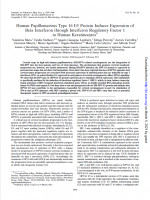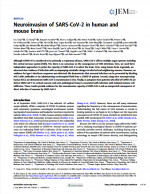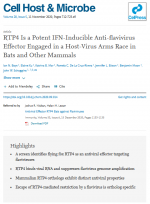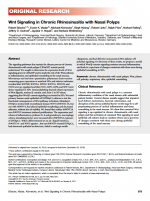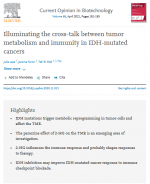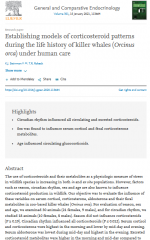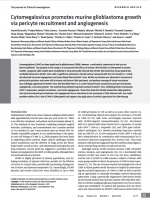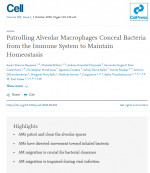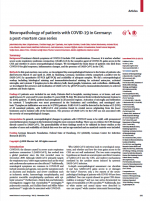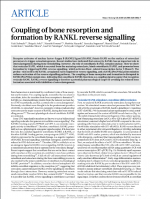05.03.2021
Human Papillomavirus Type 16 E5 Protein Induces Expression of Beta Int... Journal of Virology, 2011
Abstract Crucial steps in high-risk human papillomavirus (HR-HPV)-related carcinogenesis are the integration of HR-HPV into the host genome and loss of viral episomes. The mechanisms that promote cervical neoplastic progression are, however, not clearly understood. During HR-HPV infection, the HPV E5 protein is expressed in precancerous stages but not after viral integration. Given that it has been reported that loss of HPV16 episomes and cervical tumor progression are associated with increased expression of antiviral genes that are induci...
26.02.2021
Neuroinvasion of SARS-CoV-2 in human and mouse brain Journal of Experimental Medicine, 2021
A new study by Song et al. elegantly demonstrates that SARS-CoV-2 can infect the human brain. Their findings establish a basis for the development of potential interventions to ameliorate or prevent persistent CNS-related sequelae reported in a significant number of patients who have recovered from acute SARS-CoV-2 infection. Two of GeneTex’s SARS-CoV-2 antibodies (GTX635679 and GTX632604
04.02.2021
RTP4 Is a Potent IFN-Inducible Anti-flavivirus Effector Engaged in a H... Cell Host & Microbe, 2020
Abstract Among mammals, bats are particularly rich in zoonotic viruses, including flaviviruses. Certain bat species can be productively yet asymptomatically infected with viruses that cause overt disease in other species. However, little is known about the antiviral effector repertoire in bats relative to other mammals. Here, we report the black flying fox receptor transporter protein 4 (RTP4) as a potent interferon (IFN)-inducible inhibitor of human pathogens in the Flaviviridae family, including Zika, West Nile, and hepatitis C...
22.01.2021
Wnt Signaling in Chronic Rhinosinusitis with Nasal Polyps American Journal of Respiratory Cell and Molecular Biology, 2017
Abstract The signaling pathways that sustain the disease process of chronic rhinosinusitis with nasal polyps (CRSwNP) remain poorly understood. We sought to determine the expression levels of Wnt signaling genes in CRSwNP and to study the role of the Wnt pathway in inflammation and epithelial remodeling in the nasal mucosa. Microarrays and real time-quantitative polymerase chain reaction comparing gene expression in matched NPs and inferior turbinates revealed that WNT2B, WNT3A, WNT4, WNT7A, WNT7B, and FZD2 were up-regulated and that FZD1,...
12.01.2021
Illuminating the cross-talk between tumor metabolism and immunity in I... Current Opinion in Biotechnology, 2021
The exciting review of Leca et al. (2021) summarizes the role of the Krebs cycle key enzyme IDH in the cross-talk between tumor metabolism and immunity in IDH-mutated cancers and shades light on its relevance in immunotherapeutic approaches of IDH-mutant cancers. Background: IDH is of central importance for the energy metabolism of the cell. IDH1 and 2 are mutated in numerous cancers and lead to the accumulation of the "oncometabolite" 2-hydroxyglutarate (2-HG), which directly influences tumor metabolism and "...
18.12.2020
Establishing models of corticosteroid patterns during the life history... General and Comparative Endocrinology, 2021
Like humans, marine mammals can get stressed out, and accurate stress measurement in wildlife is fundamental to understanding how animals cope with and respond to perturbations in their environment. For killer whales (Orcnius orca), environmental contamination and other anthropogenic stressors, such as vessel disturbance and fisheries, are major stressors. To better understand the stress level of whales, researchers use
04.12.2020
Cytomegalovirus promotes murine glioblastoma growth via pericyte recru... The Journal of Clinical Investigation, 2019
Abstract Cytomegalovirus (CMV) has been implicated in glioblastoma (GBM); however, a mechanistic connection in vivo has not been established. The purpose of this study is to characterize the effects of murine CMV (MCMV) on GBM growth in murine models. Syngeneic GBM models were established in mice perinatally infected with MCMV. We found that tumor growth was markedly enhanced in MCMV+ mice, with a significant reduction in overall survival compared with that of controls (P < 0.001). We observed increased angiogenesis and tumor blood flow...
02.11.2020
Patrolling Alveolar Macrophages Conceal Bacteria from the Immune Syste... Cell, 2020
Abstract During respiration, humans breathe in more than 10,000 liters of non-sterile air daily, allowing some pathogens access to alveoli. Interestingly, alveoli outnumber alveolar macrophages (AMs), which favors alveoli devoid of AMs. If AMs, like most tissue macrophages, are sessile, then this numerical advantage would be exploited by pathogens unless neutrophils from the blood stream intervened. However, this would translate to omnipresent persistent inflammation. Developing in vivo real-time intravital imaging of alveoli...
08.11.2020
Neuropathology of patients with COVID-19 in Germany: a post-mortem cas... The Lancet, 2020
Prominent clinical symptoms of COVID-19 include CNS manifestations. However, it is unclear whether severe acute respiratory syndrome coronavirus 2 (SARS-CoV-2), the causative agent of COVID-19, gains access to the CNS and whether it causes neuropathological changes. Here, Matschke et al. investigated the brain tissue of patients who died from COVID-19 for glial responses, inflammatory changes, and the presence of SARS-CoV-2 in the CNS. The group detected fresh territorial ischaemic lesions in six (14%) patients. 37 (86%) patients had astrogliosis in a...
27.10.2020
Coupling of bone resorption and formation by RANKL reverse signalling Nature, 2018
Receptor activator of nuclear factor-kappa B (RANK) ligand (RANKL) binds RANK on the surface of osteoclast precursors to trigger osteoclastogenesis. Recent studies have indicated that osteocytic RANKL has an important role in osteoclastogenesis during bone remodelling; however, the role of osteoblastic RANKL remains unclear. Here we show that vesicular RANK, which is secreted from the maturing osteoclasts, binds osteoblastic RANKL and promotes bone formation by triggering RANKL reverse signalling, which activates Runt-related transcription factor 2 (R...



